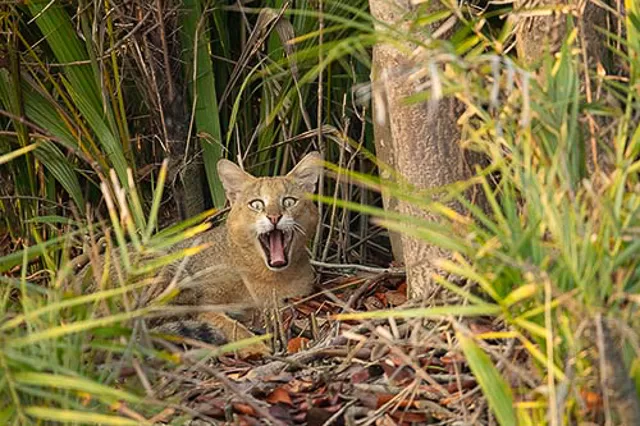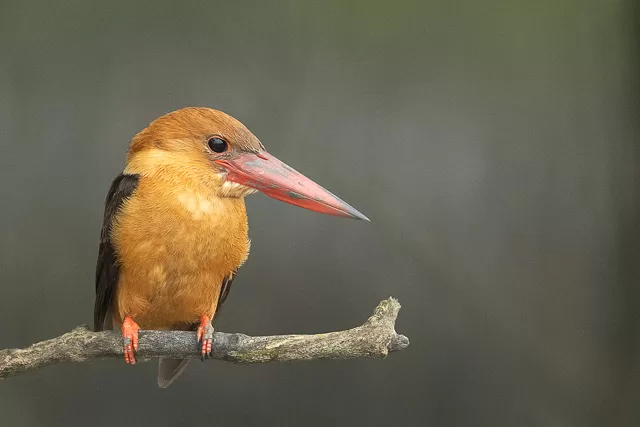About
Top Experiences
Type of Journey
Subscribe to newsletter and stay updated
Read about our travel expeditions, new destinations, new pictures, latest trip schedules
The Sundarbans is a cluster of 56 low-lying islands in the Bay of Bengal. Expanding over India and Bangladesh, Sundarbans has been enlisted as a UNESCO World Heritage Site. These mangrove forests sprawl across 4267 sq.km of land and have a unique ecosystem. The Sundarbans Forest harbors about 248 species of birds, 48 species of reptiles, and 58 species of mammals.
One of the most popular attractions of the Sundarbans is the Royal Bengal Tiger or the Sundarbans Tiger. The majestic and elusive creature is revered by every boatman, each with a personalized tale of its ferocity, power, and intellect.
Sundarbans is the largest estuarine forest in the world. Life is harsh and conflict-riddled here. The animals here are elusive and tend to display very different characteristics as compared to their counterparts in other forests.
OVERVIEW
Location: 24 Parganas district, West Bengal, India
Nearest Airport: Kolkata airport
How to reach: 3 hours from Kolkata airport
Famous for: Vast mangrove forest,
Maneater Tigers
Best time to visit: November to April
WHAT TO SEE
Mammals: Royal Bengal tiger, jungle cat, fishing cats, leopard cats, macaques, wild boar, Indian grey mongoose, fox, jungle cat, flying fox, pangolin, chital
Birds: Dusky eagle owl, brown fish owl, brown winged kingfisher, white collared kingfisher, Red junglefowls, spot-billed pelicans, great egrets, cormorants, seagulls, common kingfishers, peregrine falcons, woodpeckers, northern pintails, and whistling teals.
The Sundarbans National Park is not only a national park but also a tiger and biosphere reserve. The densely covered mangrove forests including the adjoining Sundarbans Forests of Bangladesh is one of the largest reserves for the Royal Bengal Tiger. It was declared as the Sunderbans Tiger Reserve in 1973 and in 1984, it was declared as the Sundarbans National Park. It was enlisted as a UNESCO World Heritage Site in 1987 and as a Ramsar site in 2019.
This estuarine delta is formed by seven main rivers and innumerable watercourses in the area which form a network of water channels in the Sundarbans Forests. Life here dances to the tunes of ebb and flow of the tides. However, the constantly increasing population has led to the thinning of the mangroves and subsequently, shore erosion.
The Sundarbans forest is home to as many as 35 species of mammals. These animals depend on the forests for shelter, roost, feed, and breed. Depending on the varied habitats of the forest, the animals can be terrestrial, marine, or estuarine.

At the apex of the food chain is the tiger who is well adapted to the habitat. Although initially, its numbers were around 242, recent surveys have recorded constant dwindling in the numbers. The Sundarbans tigers are difficult to sight since the dense Sundarbans forests offer perfect camouflage. Due to the availability of numerous rivers and watercourses, the Sundarbans tigers have taken to fishing as their main source of food and their daily water intake consists of almost 3% salt. The tigers in this area are great swimmers and can swim against the powerful tides. However, the tigers face threats in the water from the sharks and saltwater crocodiles.

In the grassy and forested areas of the forests, the chital can be seen in herds, interacting with the rhesus macaques on treetops. The wild pig and fishing cat are other terrestrial animals in this region. The Indian pangolin and the Bengal fox reside in the mangroves along with two species of mongoose, a variety of otters, several venomous snakes, bats, and rodents. The rivers and streams abound in the estuarine or saltwater crocodile (Crocodylus porosus) and the water monitor. The saltwater crocodile is the largest and rarest species of crocodile alive. The nesting regions of Halliday Island is home to endangered species like the freshwater turtle, Batagur Baska, and the Marine olive Ridley turtle.

To have a good experience, certain things should be kept in mind by the guests. The guests can choose different options to travel to the Sundarbans like:-
Guests can travel through the waters. They can travel on a private boat and can cruise around and sleep in it. Guests can also stay at the Sajnekhali guest Lodge which is operated by the West Bengal Tourism Development Corporation.
Guests can alternatively stay at a hotel or a resort from the limited options available at the Sunderbans Forests. There are transport options from Kolkata and also various tours and cultural programs.
Private or shared boat trips of various durations often start from Sonakhali, Godkhali, and Canning. The boat ride from Godkhali is the most convenient as it is nearest to the Sundarban National Park.

Watchtowers:
There are several watchtowers in this region, some of which are located far away and can require a full day return trip by boat. The most popular among these watchtowers are Sajnekhali, Dobanki, and Sudhanyakhali.
Sajnekhali: It is the main watchtower complex and is a favorite among birdwatchers.
Sudhanyakhali: This watchtower is where most of the tigers are sighted from. The nearby pond is frequented by families of deer.
Burir Dabri: It is located on the Raimangal river adjoining Bangladesh, around 5 hours away from Sajnekhali. The place boasts of the picturesque view, a canopy-walk over the mangroves that leads to a viewpoint with a panorama of Bangladesh, and a mud walk.

Do Banki: It has a 20-foot-high enclosed canopy walk that extends for around 150 meters.
Netidhopani: The ruins of a 400-year old temple can be found here. Special permits are required to visit this area and so, the number of visitors is comparatively less.
Bonnie Camp: This is the highest watchtower in the Sundarbans. The 50-feet-tall scenic watchtower is located close to the Bay of Bengal and takes about 6 hours to reach from Sajnekhali. guests can stay at a guest rest house nearby.
Jhingekhali: Located on the eastern-most fringe of the Sundarbans, this watchtower is often overlooked for its remoteness. It is a quiet place that boosts the chances of spotting a tiger. Different varieties of birds can also be spotted from this region.